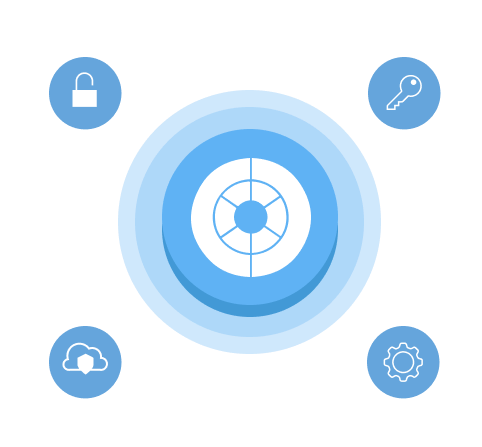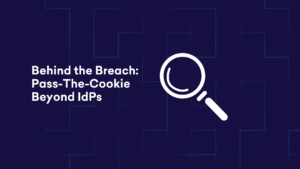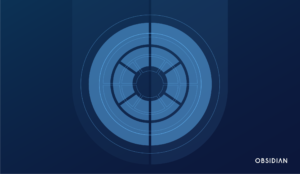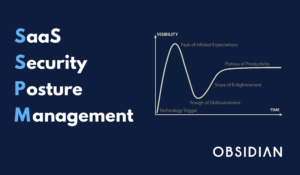What is SSPM?
SaaS Security Posture Management (SSPM) is a solution that automates the continuous monitoring of cloud-based applications with the purpose of minimizing security risks, adhering to regulatory and organizational compliance standards, and promptly mitigating threats.
Proactive risk reduction is, as the name suggests, the identification and reduction of vulnerabilities that expose sensitive data or that attackers can potentially exploit. SSPM solutions help security teams manage risk introduced by misconfigured SaaS settings, excessive user privileges, and third-party integrations connected to your environment.
Even with proactive measures in place, threat monitoring is important to help security teams detect and mitigate malicious activity when it appears across the SaaS estate. SSPM solutions continuously baseline user behavior with machine learning to accurately identify account compromises and insider threats in critical applications.
What are some examples of SaaS security threats?
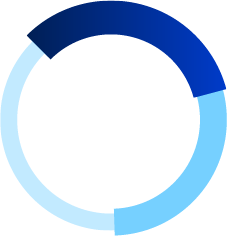 1
1
What is SaaS security posture?
SSPM tools are specifically designed to help organizations better manage their SaaS security posture—but what exactly does that mean?
Put simply, SaaS security posture is a measure of risk across all of the SaaS applications in your environment. Several individual components factor into this measure, and SSPM solutions should give you complete and continuous visibility into each and every one:
Configurations provide granular control over SaaS applications and allow you to tailor the use of the application to your organization’s specific security needs and preferences. SSPM solutions maintain a consolidated inventory of controls and surface opportunities to improve them.
Privileges delegated to users provide elevated capabilities and access to restricted data. To minimize risk, SSPM solutions help ensure that these permissions are only entrusted to users whose responsibilities require them.
Users accessing your SaaS applications come in all shapes and sizes, from customers and third-party contractors to highly privileged application administrators. Monitoring user behavior with SSPM to identify malicious patterns informs prompt investigation and threat remediation
Integrations are one of the greatest advantages of SaaS, but the complex interconnections within a modern SaaS environment typically aren’t visible to security teams with their traditional tools. Maintaining a clear inventory of third-party and custom in-house integrations while monitoring their permissions is a vital part of SSPM.
The fifth and final component of SaaS security posture ties every other piece together and gives them life, so to speak.
Activity tells you exactly how your users, integrations, and applications are communicating and interacting with each other across the SaaS environment. Activity data enriches and contextualizes security team decision making around every part of the application by providing answers to important questions:
- “Does this user actually use their privileges, or can they be safely removed?”
- “Are any weak application configurations being actively exploited?”
- “Is this user or third-party integration behaving unusually?”
Continuous activity monitoring with SSPM helps security teams to combat threats and make posture changes without worrying about unintentionally disrupting users and business operations.
 2
2
Why is SSPM important?
The adoption of SaaS applications by modern organizations has introduced an unprecedented capacity for business agility, productivity, and collaboration—but it’s also introduced a new and complex vector for security teams to manage.
Any business unit leader can deploy a new application for their team, but the continued management and security of the service is usually of minimal concern to them. This means that security teams are tasked with protecting sensitive data across a SaaS environment that’s complicated, always changing, and into which they have almost no visibility or control.
SSPM addresses the visibility and resource limitations that security teams face by providing a scalable, accessible, and easy to use solution for SaaS security.
Manual SaaS security requires extensive SaaS expertise and an impossible time commitment from even the most mature team. By automating this process and delivering actionable recommendations, SSPM makes better SaaS security possible. As sensitive business data and workloads increasingly migrate to cloud applications, the importance of SSPM will only continue to grow.
 3
3
How does SSPM compare?
The relatively recent emergence of SSPM has prompted questions about how it compares to other solutions and where SSPM fits in a wider security stack.
While not designed specifically for the primary purpose of SaaS security, traditional cybersecurity solutions have been expanded or adapted to offer narrow coverage for specific parts of SaaS. Still, none of these solutions offer the comprehensive insight and security for SaaS applications that SSPM does.
To recognize the significance of SSPM in modern cybersecurity deployments, it’s helpful to understand how it integrates with and improves what’s already in use.
SSPM vs CASB
Cloud Access Security Brokers (CASB) are deployed between cloud applications and user clients in order to intercept and examine traffic in transit. These proxy-based solutions are commonly deployed in order to identify data exfiltration and limit unsanctioned shadow IT across the organization.
While CASB providers have adapted their solutions to accommodate the realities of modern SaaS environments, their solutions can oftentimes be costly, difficult to maintain, and still fundamentally blind to threat vectors such as high-risk integrations and cross-application activities. Proxy-based solutions can’t inspect traffic that doesn’t run through them and can’t identify malicious activity until data exfiltration is already in progress.
As a purpose-built SaaS security solution, SSPM provides immediate expertise and risk assessment for your business-critical applications without the heavy investment. Continuous activity modeling allows security teams to mitigate threats in their earliest stages—before valuable data is already lost.
SSPM vs SIEM
Security information and event management (SIEM) solutions aggregate and analyze events from a variety of data sources across an organization, including IT infrastructure, applications, devices, network logs, and security events. These reports provide security teams with consolidated supporting information to help with threat detection, root-cause analysis, and compliance, among other use cases.
Although SIEMs are effective at compiling information from across the enterprise, they are fundamentally general purpose solutions that collect an oftentimes overwhelming amount of data. Navigating this data to surface clear, actionable SaaS insights requires significant expertise and a nontrivial investment of time and budget.
On the other hand, SSPM solutions are designed specifically for SaaS and present a much clearer assessment of your environment. This means immediate, out-of-the-box expertise in the form of continuous threat detections informed by machine learning and posture hardening recommendations designed to proactively minimize risk. Building out your SIEM to meet the security needs of a unique, dynamic SaaS environment is a massive undertaking—the right SSPM solution can deliver those improvements right away.
SSPM vs IAM
Identify and Access Management (IAM) solutions are widely recognized for their efficacy in helping organizations manage digital identities and regulate access to business applications. Features like single sign-on, multi-factor authentication, and granular access control can provide better experiences for users while simultaneously deterring unauthorized access incidents.
The effectiveness of IAM in providing a strong first line of defense is the reason these solutions have become so commonplace. Still, when it comes to SaaS, IAM solutions are first and foremost initial lines of defense. Attackers can bypass these measures and establish discrete, persistent access in your SaaS environment.
With a fundamentally deeper understanding of your applications, SSPM solutions are able to identify these attacks and other various other malicious activities, including insider threats. If IAM is seen as a strong front door, then SSPM can be considered security monitoring within the home.
